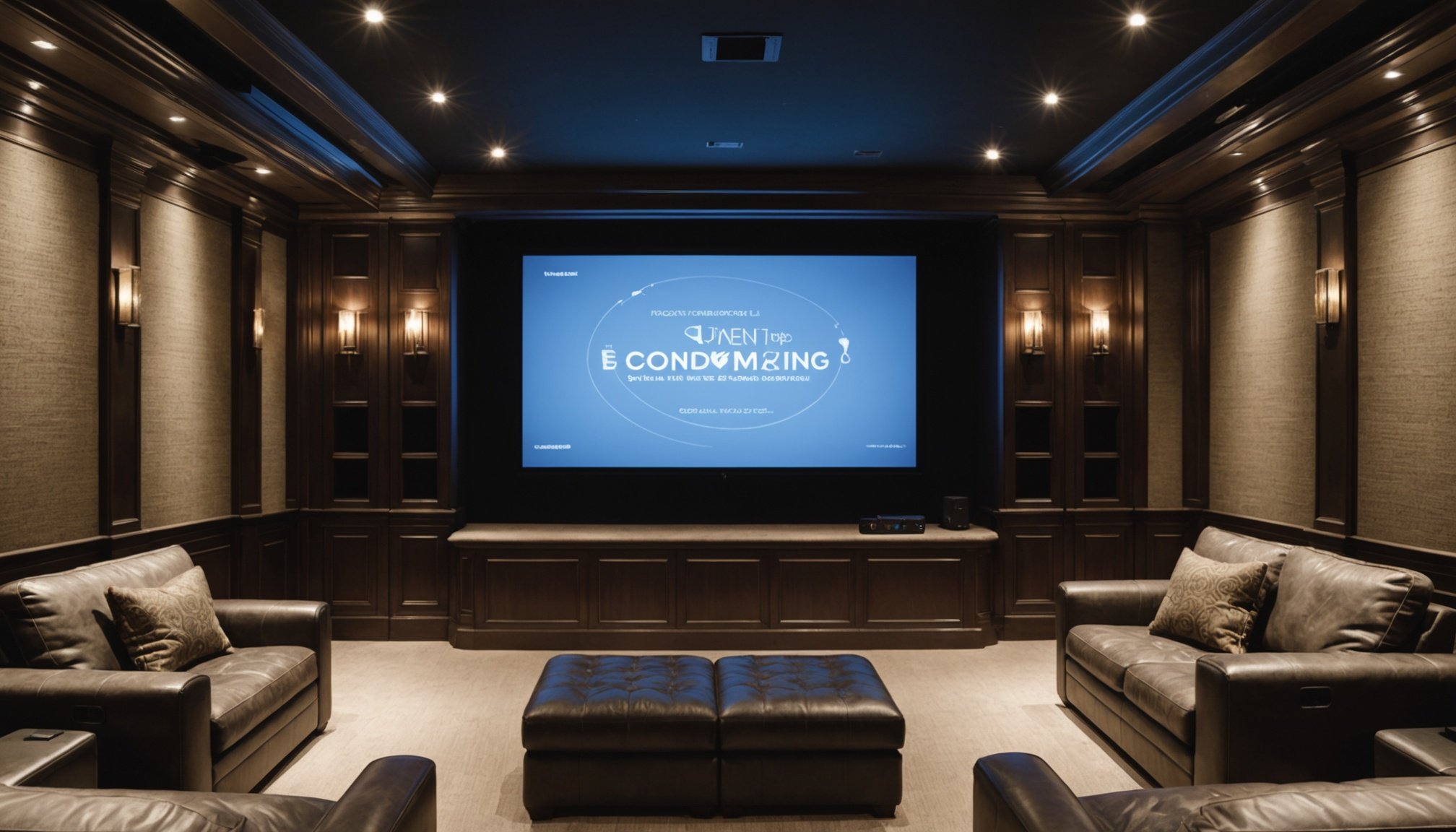Unveil the Best Soundproofing Solutions for the Ultimate Home Theater Experience
Creating the perfect home theater is a dream for many, but it often comes with a significant challenge: achieving optimal sound quality. To immerse yourself fully in the audio and visual experience, you need to ensure your home theater is well soundproofed. Here’s a comprehensive guide to help you uncover the best soundproofing solutions for your home theater.
Understanding the Importance of Soundproofing
Before we dive into the solutions, it’s crucial to understand why soundproofing is essential for a home theater. Soundproofing involves reducing the transmission of sound waves between rooms and minimizing external noise interference. Here are a few reasons why it’s vital:
This might interest you : Unlock budget-friendly techniques for installing underfloor heating in concrete surfaces
- Enhanced Sound Quality: By absorbing or blocking sound waves, you can prevent echoes, reverberations, and external noises from disrupting your audio experience.
- Privacy: Soundproofing ensures that the sound from your home theater does not disturb others in the house or neighbors.
- Immersive Experience: A well-soundproofed room allows you to fully immerse yourself in the movie or music without distractions.
Acoustic Panels: The Heart of Soundproofing
Acoustic panels are one of the most effective and popular solutions for soundproofing. Here’s why they are a must-have for your home theater:
How Acoustic Panels Work
Acoustic panels are designed to absorb sound waves, reducing echo and reverberation in a room. They are typically made from materials like acoustic foam, fiberglass, or polyester fiber, which are excellent at absorbing sound energy[2].
This might interest you : Illuminate your imagination: crafting your ideal home library bathed in natural light
Installation and Versatility
Acoustic panels come in various sizes and shapes, making them versatile for different spaces. They can be easily installed on walls, ceilings, or even floors using adhesives, screws, or double-sided tape. For example, the VallisCo acoustic panels are lightweight and easy to install, making them perfect for home studios, offices, and home theaters[1].
Design and Aesthetics
Acoustic panels are not just functional; they also add a modern touch to your room. You can choose from different colors and designs to match your décor. The UMIACOUSTICS sound-absorbing panels, for instance, come in an art curve shape and are made from flame-retardant, odorless materials, making them both functional and decorative[3].
Other Essential Soundproofing Materials
While acoustic panels are a cornerstone of soundproofing, other materials and techniques can enhance your home theater experience.
Bass Traps
Bass traps are specifically designed to handle low-frequency sound waves, which can be particularly problematic in home theaters. These traps absorb the low-frequency energy, preventing it from bouncing around the room and causing unwanted resonances[2].
Acoustic Diffusers
Acoustic diffusers scatter sound waves in different directions, creating a more balanced and natural acoustic environment. They are especially useful in rooms where sound quality is critical, such as recording studios and home theaters. Unlike acoustic panels, diffusers do not absorb sound but rather redirect it, reducing echoes and improving overall sound quality[2].
Sealing Gaps and Cracks
Even small gaps and cracks in walls, ceilings, and floors can let sound in or out. Sealing these with acoustic sealant or foam tape is crucial for maintaining sound isolation. This simple step can significantly improve the effectiveness of your soundproofing efforts[2].
Strategic Placement of Soundproofing Materials
The placement of soundproofing materials is as important as the materials themselves. Here are some tips for optimal placement:
Room Acoustic Optimization
To optimize the acoustics of your room, you need to understand how sound waves travel within the space. Acoustic panels should be placed in areas where sound waves tend to reflect the most, such as between speakers and the listening position. Bass traps should be placed in corners where low-frequency energy tends to accumulate[2].
Speaker Placement
The placement of your speakers is also critical. Ensuring that speakers are positioned in a way that minimizes sound reflections and resonances can significantly enhance sound quality. For example, placing speakers away from walls and corners can help reduce unwanted reflections.
Practical Tips for Soundproofing Your Home Theater
Here are some practical tips to help you soundproof your home theater effectively:
Use a Combination of Materials
Using a combination of acoustic panels, bass traps, and diffusers can provide a comprehensive soundproofing solution. For instance, you could use acoustic panels on walls and ceilings, bass traps in corners, and diffusers on surfaces where sound waves tend to reflect.
Consider the Room’s Dimensions
The dimensions and shape of your room can affect sound quality. Optimize the room’s dimensions to minimize unwanted reflections and resonances. For example, a room with a rectangular shape can help distribute sound waves more evenly.
Add Soundproofing Curtains
Soundproofing curtains can be an effective addition to your soundproofing strategy. These curtains are made from thick, heavy materials that can absorb sound waves and reduce external noise. They can be hung on walls or used as room dividers.
Comparative Analysis of Soundproofing Materials
Here is a comparative table to help you choose the best soundproofing materials for your home theater:
| Material | Description | Pros | Cons |
|---|---|---|---|
| Acoustic Panels | Absorb sound waves, reducing echo and reverberation | Easy to install, versatile, aesthetic appeal | May require additional adhesive for secure installation |
| Bass Traps | Absorb low-frequency sound waves | Effective in reducing low-frequency resonances | Typically larger and more expensive than acoustic panels |
| Acoustic Diffusers | Scatter sound waves in different directions | Improve sound quality by reducing echoes | Can be more complex to install and position |
| Soundproofing Curtains | Absorb sound waves, reduce external noise | Easy to install, can be used as room dividers | May not be as effective as other materials for high-frequency sounds |
| Sealing Gaps and Cracks | Seal small gaps and cracks with acoustic sealant or foam tape | Simple and cost-effective | Requires thorough inspection of the room |
Real-Life Examples and User Experiences
To give you a better understanding of how these solutions work in real-life scenarios, here are some user experiences:
VallisCo Acoustic Panels
“I installed the VallisCo acoustic panels in my home studio, and the difference was night and day. The panels efficiently absorb echoes and unwanted noise, creating a much cleaner sound environment for recording and mixing. The installation was simple, and the foam feels durable yet lightweight,” says a satisfied user[1].
UMIACOUSTICS Sound-Absorbing Panels
“I used the UMIACOUSTICS sound-absorbing panels in my home theater, and they work a little to soften inside and outside noise. They are great, look good, and are an easy, cost-effective solution,” notes another user[3].
Creating the ultimate home theater experience involves more than just selecting the right audio equipment; it requires a well-thought-out soundproofing strategy. By understanding the role of acoustic panels, bass traps, diffusers, and other soundproofing materials, you can design a space that offers high-quality sound and an immersive experience.
Remember, the key to effective soundproofing is a combination of the right materials and strategic placement. Here are some final tips to keep in mind:
- Use a variety of soundproofing materials to address different aspects of sound quality.
- Optimize your room’s dimensions and surface materials to minimize unwanted reflections and resonances.
- Pay attention to speaker placement to ensure the best sound distribution.
- Seal all gaps and cracks to maintain sound isolation.
By following these guidelines and choosing the best soundproofing solutions for your needs, you can transform your home theater into a sanctuary of sound, where every movie night or music session is a pure delight.











